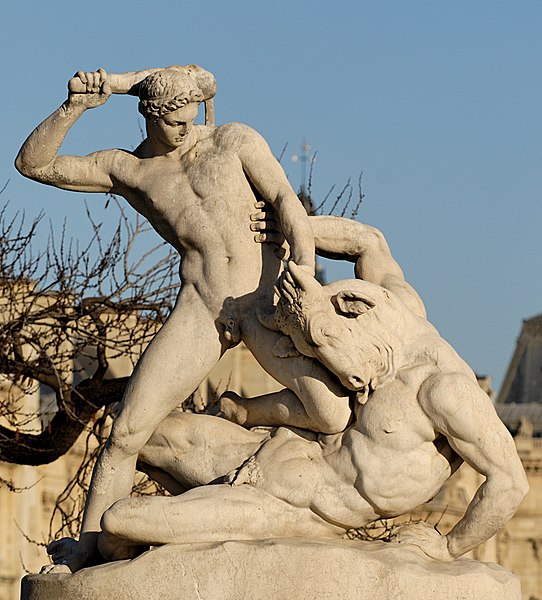 In all of the myths I have read, all of them sad in their own right, none has quite bothered me more than that of the minotaur. I think what strikes me so is that the minotaur...well, he isn't a monster, by any means. It's true, like the common misconceptions about Frankenstein's monster, that the minotaur was misunderstood by the majority of the literary and artistic community. George Fredrick Watts got it right, however (right).
In all of the myths I have read, all of them sad in their own right, none has quite bothered me more than that of the minotaur. I think what strikes me so is that the minotaur...well, he isn't a monster, by any means. It's true, like the common misconceptions about Frankenstein's monster, that the minotaur was misunderstood by the majority of the literary and artistic community. George Fredrick Watts got it right, however (right).He was, in fact, a hybrid between a human and animal. This human was Pasiphae, wife of King Minos of Crete. The animal was a bull sent by Neptune. The exact details of their union are...as creepy and wrong as you would expect. She didn't have some fetish for these creatures, it was a "spell", for the lack of a better term. When Minos did not follow through with his promise of sacrificing a fine beast to Neptune he cursed Pasiphae in retaliation.
 Pasiphae, now stricken with a lust for the bull Neptune sent, had Daedalus (father of Icarus, who's disobedience cost him his life) build her a wooden cow in which she could place herself. This little trick was successful as it mated with her and she soon became pregnant with an abomination of nature. She gave birth to a half-bull and half-human hybrid they named Minotaur, which means "Minos bull". They then shut him away in a labyrinth which was also constructed and designed by Daedalus.
Pasiphae, now stricken with a lust for the bull Neptune sent, had Daedalus (father of Icarus, who's disobedience cost him his life) build her a wooden cow in which she could place herself. This little trick was successful as it mated with her and she soon became pregnant with an abomination of nature. She gave birth to a half-bull and half-human hybrid they named Minotaur, which means "Minos bull". They then shut him away in a labyrinth which was also constructed and designed by Daedalus.Every year he was fed seven young men and young women as a tribute to the king. One year a prince named Theseus was selected and he killed the bull, with the help of Aridane, Minos's daughter.
What is so disheartening about this is his imprisonment and treatment. He was simply a hybrid, and as awful and monstrous as he seemed, he had to have more going on. In the painting done by Watts we get the sense of sadness and longing. He wants freedom and acceptance. This image and idea of a wanting and misunderstood creature has resonated with artists world over. His figure has been remastered and represented by artists well into the modern era, even Picasso took a swing at it. It has even been adapted into an opera by Harrison Britwistle and David Harsent, it opened in the fall of 2008 in London.
 Maybe he did become evil in his own way, but perhaps his environment made him that way. Like Frankenstein's monster he was a product of his unusual entrance into the world and upbringing. There is an Etruscian view that offers us an alternative perspective, we see his mother balancing the infant minotaur on her knee, lovingly holding him in her arms. We make him the antagonist but we forget he had a mother and was part human himself. It isn't up to us to decided which part that was.
Maybe he did become evil in his own way, but perhaps his environment made him that way. Like Frankenstein's monster he was a product of his unusual entrance into the world and upbringing. There is an Etruscian view that offers us an alternative perspective, we see his mother balancing the infant minotaur on her knee, lovingly holding him in her arms. We make him the antagonist but we forget he had a mother and was part human himself. It isn't up to us to decided which part that was. Maybe I'm too sensitive about it, but I think alternate views are important and I tend to have a bleeding heart for these misunderstood figures that dawn the pages of our art and history books.

The Minotaur is a symbol of man's animal..egotistical desires raging out of control devouring the other 7 aspects(chakras, if you will) of the soul or personality as represented by the seven maidens and boys he regularly devoured.
ReplyDeleteHe was also a product of desire...the white bull was kept by King Minos rather than gifted to Poseidon as promised. He gave in to his desires and in turn Poseidon sought to teach Minos a lesson by causing Pasiphae to lust after the bull and create the Minotaur-a menacing fearful beast that he hid away from sight.
Theseus represents the higher self overcoming his baser, more destructive desires.
ReplyDelete